More info
Datasheet
| Aquarium Compatible | yes |
| Plant Outdoor | unknown |
| Plant Emersed Growth | yes |
| Plant Growth | fast |
| Temperature Tolerance | 12°C / 53.60°F - 28°C / 82.40°F |
| Temperature | 24°C / 75.20°F - 26°C / 78.80°F |
| Carbonate Hardness | 2-15 kh |
| pH Value | 4.5-7 ph |
| Light | medium-high |
| Carbon Dioxide (CO2) | 20-40mg/lmg/l |
| Nitrate (NO3-) | 10-50mg/lmg/l |
| Phosphate (PO43-) | 0.1-3mg/lmg/l |
| Potassium (K+) | 5-30mg/lmg/l |
| Iron (Fe) | 0.01-0.5mg/lmg/l |
General Description:
Ludwigia arcuata, commonly known as Piedmont primrose willow, is a delicate-looking species of Ludwigia. Originating in the southeastern USA, it thrives in aquatic environments, specifically along rivers, pond edges, and boggy areas. The plant exhibits reddish, ramifying stems and requires ample light and nutrient supply for successful cultivation.
Aquarium Suitability:
Acknowledged as an easy plant to cultivate, Ludwigia arcuata is a suitable choice for aquariums, especially those without CO2 injection systems. When adequately cared for, this plant can flourish and add a vibrant accent to aquarium settings.
Demands and Hardiness:
This plant demands sufficient light and nutrients, particularly micronutrients to maintain its reddish coloration. While macronutrients are usually present through fish food, additional supplementation of nitrate, phosphate, and potassium may be necessary if CO2 fertilization is absent.
Aquascaping & Usage:
Best utilized in groups of at least 6 stems, Ludwigia arcuata is ideal for the midground of aquariums. Its red and golden leaves create a striking contrast against darker backgrounds or alongside small-leaved plants like Hemianthus micranthemoides or Rotala rotundifolia 'Green'.
Propagation:
Propagating Ludwigia arcuata is straightforward, involving the cutting and replanting of lateral shoots or top shoots. Due to its delicate structure, ensuring planted groups of a minimum of 6 stems will enhance its visual impact in aquascape designs.
Habitat and Distribution:
The natural habitat of Ludwigia arcuata spans the southeastern region of the USA, where it thrives in aquatic environments such as rivers, pond edges, and swampy areas. This species is known for its fast growth rate and easily adaptable nature in suitable conditions.

